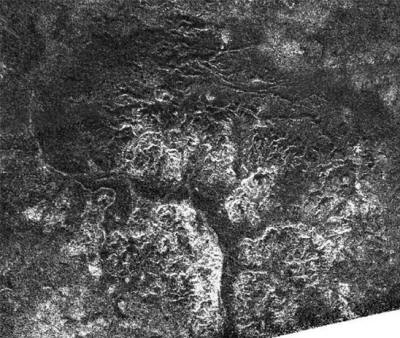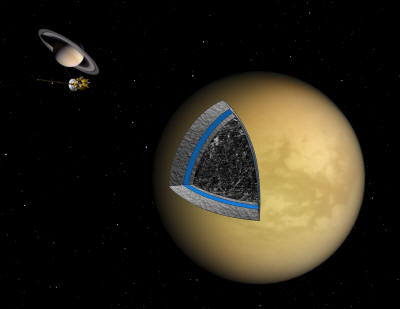|

by Stephen Smith
May 16, 2011
from
Thunderbolts Website

Canyons in
Titan's southern latitudes.
Credit: NASA/JPL
Considering the variety of Saturn's
moons, it would be difficult to identify them as members of the same
family.
They vary in size, chemical composition,
temperature, and appearance. However, superficial appearances are
often misleading when it comes to overall qualities or
characteristics. Powerful
electromagnetic connections with their
giant parent planet indicate they share common traits.
A recent
press release states that a gravity map of
Titan, created
by monitoring changes in the Cassini orbiter's speed as it flew by
the giant moon between February 2006 and July 2008, shows that its
interior is a mixture of rock and ice with no layering (below image).

The orbital
variations were measured by the Earth-based
Deep Space Network as
Titan's gravity "pushed and pulled" Cassini in its flight path.
Analyzing those gravitational tics
provides data for computer models of Titan's core.
Since the variations in gravity suggest a variation in density, and
that variation is so subtle, there are no "mascons" of rock
distributed through Titan's body as there are inside Earth's Moon.
Instead, the rocks and ice are thought to be compacted into a
relatively homogeneous interior structure.
As written in previous Picture of the Day articles, many of
Titan's
anomalies can be explained if a youthful aspect is considered. Titan
might be only a few thousand years old and not the billions of years
required by conventional astrophysics. If that is the case, then the
presence of its dense atmosphere, lacking a mechanism for
replenishment, can be attributed to that youth.
Since Titan is relatively young, its
atmosphere is not in equilibrium. It is losing methane at a
measurable rate. That atmospheric loss requires methane production
somewhere on or in the moon's body if it is ancient.
The canyons and "rilles" on Titan's surface are thought to be
“drainage channels” from the methane rains that must periodically
fall to feed the “rivers,” although no precipitation was detected.
However, in an Electric Universe the canyons are blast marks etched
into Titan’s surface from tremendous lightning discharges.
They
point to the moon's savage electrical birth. Their dendritic forms are called
Lichtenberg figures, which look like some river systems on Earth.
That recent electrical birth, possibly resulting from a double layer
overload within Saturn, also explains Titan's homogeneous core.
Electric Universe theory proposes that the progeny of stars or
planets are not all born at the same time as the parent. They are born hierarchically at
intervals, and typically from within the parent. They are ejected.
If Titan was ejected from Saturn in a paroxysm, then its atmosphere
and surface features are the results of that catastrophic event.
Its
interior could be electrically charged, either from a continuous
circuit connection with Saturn or because it retains a remanent
discharging current flow. Possibly both.
The small effects on
Cassini could be electrical in nature.
If so, the "gravitational effects" on
Cassini could indicate that Titan is exerting an electric force on
the spacecraft.
|


